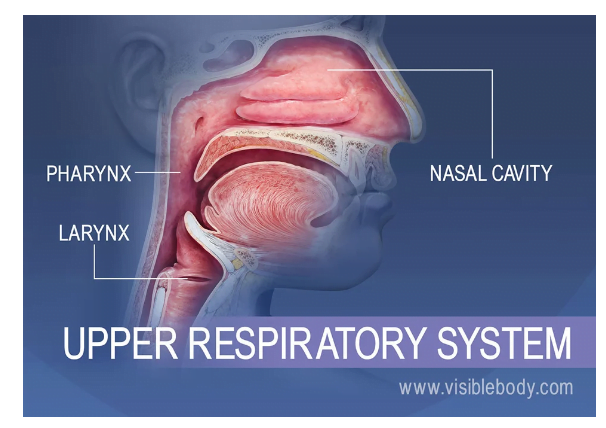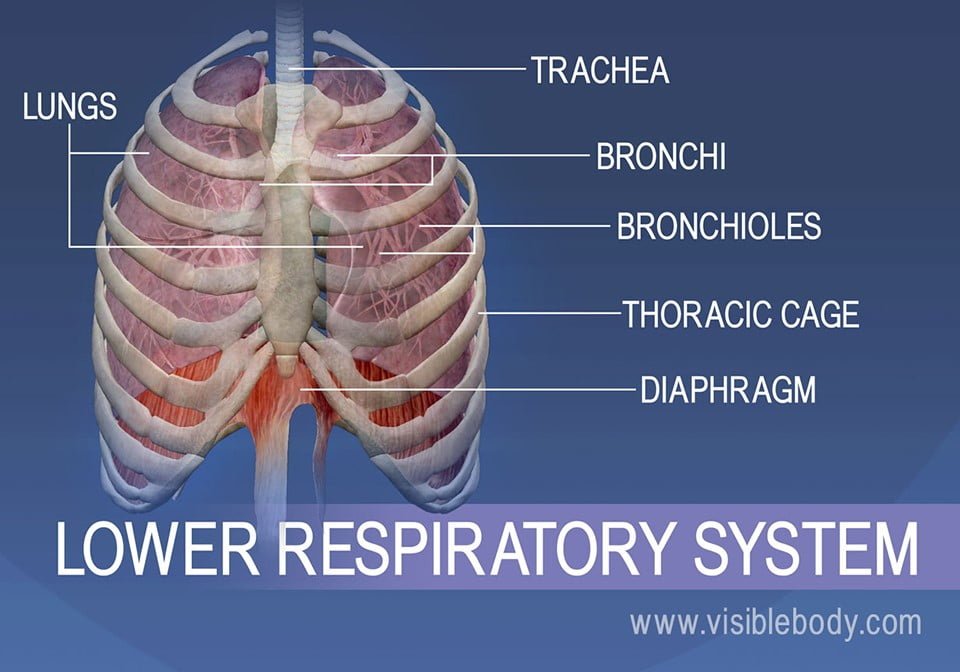The human respiratory system is a vital organ system responsible for the exchange of gases, ensuring the continuous supply of life-sustaining oxygen while expelling waste gases like carbon dioxide. Comprising a complex network of organs and structures, it includes the nose, nasal cavity, sinuses, mouth, throat (pharynx), voice box (larynx), windpipe (trachea), diaphragm, lungs, bronchial tubes, bronchioles, air sacs (alveoli), and capillaries.
What is the respiratory system?
The human respiratory system is a gas exchanging organ in which parts of it work together in pumping a continuous flow of oxygen and cleaning out waste gases like carbon dioxide.
Respiratory system is a network of organ parts that involves nose and nasal cavity, sinuses, mouth, throat (pharynx), voice box (larynx), windpipe (trachea), diaphragm, lungs, bronchial tube / bronchi, bronchioles, air sacs (alveoli) and capillaries.
How does Human Respiratory System work?
The muscles are also involved during respiration. The organ parts, muscles and tissues all work together to bring the atmospheric oxygen into the blood stream via systems of windpipe and funneled into a lung and then pushes carbon dioxide out of the blood into the surroundings.
Functions of respiratory system:
- Inhaling of oxygen and exhaling out carbon dioxide is a primary function of the respiratory system.
- Other functions include provides vibration of vocal cords and sensation of smell.
- It delivers oxygen for each and every cell and corner of our body for proper functioning and metabolism.
- It protects our body from dust, allergens and pathogenic microorganisms by producing mucous that prevents from entering into our body.
Morphology of the upper respiratory system:
- Nose and nasal passage
- Paranasal sinuses
- Pharynx
- The larynx

Nose and nasal passage:
- The nasal cavities provide a warm and clean air we inhale through the nostrils.
- The nasal conchae are a scroll shaped bone that swirls the air to warm and clean it before it enters the lung.
- The nose hair (epithelial cilia) and mucus traps the unwanted particles and filters the warm air into the nasopharynx.
Paranasal sinuses:
- Paranasal sinuses are two sets of pair air filled cavities that are located in four skull bones – the maxilla, frontal, ethmoid and the sphenoid bone.
- The mucosa of the nose contains mucus secreting gland which forms mucus when the air enters the sinuses and drains it into the nasopharynx.
Pharynx:
Pharynx or throat is shaped like a funnel, and it can be divided into three floors:
- Nasopharynx
- Oropharynx
- Hypopharynx
- Nasopharynx serves a passage for air to the oropharynx. It is also connected to the middle ear cavity therefore while swallowing; it opens and creates an air and pressure to the auditory tubes. The pharyngeal tonsil is also associated on the posterior wall of the nasopharynx.
- Oropharynx is connected to the mouth or oral cavity where both air and food are passed down to the hypopharynx.
- Hypopharynx is the lowest part which is connected to the posterior part of the tongue and connects to the larynx and the esophagus. During swallowing, it controls the trading of air and food.
The larynx:
- Upper portion of larynx is connected to the lower part of the pharynx which is known as laryngopharynx.
- It is a key organ for vocal cord. Not only it produces sound, but it also vibrates the air above them where trained singers control and finely tunes them.
- A number of muscles control the laryngeal nerves, and its skeleton consists of cartilage which is connected by ligaments and membrane. Thyroid cartilage is the largest among them.
- Laryngoscope is an instrument for the visualization of an interior part of the larynx.
Morphology of the Lower respiratory system
Trachea, lungs, bronchi, bronchioles and alveoli
- Trachea
- The lungs, Bronchi, Bronchioles and alveoli

Trachea:
- Trachea is a tube about 10 to 12cm in length and 2cm width. Its interior is lined by the respiratory epithelium.
- Trachea is divided into two bronchi stem – Left and right lung.
- The right bronchus is larger than the left one because the foreign substance passes into the right lung first after crossing the larynx.
- It is an important upper airway system as it always remains open and helps to moisten and warm the air before entering into the lungs.
The lungs, bronchi, brochioles and alveoli:
- Inside the lungs, each bronchus is divided into primary, secondary and tertiary bronchi. Further bronchi are branched into bronchioles, which is a small branch of airways.
- The air sac where the bronchioles end are alveoli and bunches together to form an alveolar sac.
- Air enters through bronchi and into a small airway of bronchioles until it reaches to the air sacs of alveoli where exchange of gas occurs between the air and the blood.
- Each alveolus is covered with a network of capillaries so that the oxygen and carbon dioxide can diffuse within them.
- In this way, taking fresh oxygen and getting rid of the carbon dioxide takes place within the whole respiratory system.
RESPIRATORY DISEASES
Respiratory diseases have become a common medical condition worldwide where people acquire it genetically or from the environment like air pollution, exposure to toxic chemicals and dusts and from an unhealthy lifestyle like smoking tobacco and cigarettes and alcohol consumption.
Some common disease that affects our respiratory system includes:
Asthma:
Symptoms include difficulty in breathing due to inflammation of airways. Allergies, infection and pollution triggers to these symptoms.
Pneumonia:
Inflammation of alveoli which might be filled with fluid or pus mainly caused by the bacterial infection by Streptococcus pneumoniae.
Tuberculosis:
Mycobacterium tuberculosis infects the lungs but also affects kidney and brain.
Chronic obstructive pulmonary disease (COPD):
Trouble in breathing which gets worse over time and also causes bronchitis and emphysema.
This disease is generally caused by the habit of smoking.
Lung cancer:
Growth of tumor or irregular functioning of lungs which is also associated with inhalation of toxic chemical and smoking.
Cystic Fibrosis:
A genetic respiratory disease creating thick and sticky mucus infecting lungs and also the pancreas.
Bronchiectasis:
Abnormal dilated bronchial tubes which cause swelling and thickening of bronchial walls.
Bronchiectasis is more common in women at old age.
An additional illness – Covid-19
Covid-19 is a respiratory disease caused by a SARS-COV2. This virus transmits person to person through respiratory droplets. Symptoms of COVID-19 includes fever, chills and cough. Older people and especially all people with underlying serious medical illness are more susceptible to COVID-19.
According to the Center for Disease Control and Prevention (CDC), corona virus infects both human and animals affecting the lungs with symptoms of shortness of breath, dry cough and high fever,
Respiratory disease can be prevented by adapting healthy lifestyle by maintain weight with plenty of extra curriculum activities and balanced diet, avoiding exposure to toxic chemicals, smokes and dusts.
Human Microbiome: Unveiling Its Profound Significance (thesciencenotes.com)
References:
- MedlinePlus. (n.d.). Respiratory system.
- Britannica. (n.d.). Human respiratory system. In Britannica.
- HealthEngine. (n.d.). Respiratory system.
- Cleveland Clinic. (n.d.). Respiratory system.
- WebMD. (n.d.). How we breathe.
- Visible Body. (n.d.). Upper respiratory system.
Human Microbiome: Unveiling Its Profound Significance (thesciencenotes.com)